Asynchronous operations in Asio all expect a function object argument, the completion handler, which they invoke when the asynchronous operation completes. The signature of the handler depends on the type of operation. For example, a handler posted using io_service::post() must have the signature:
void handler();
while an asynchronous wait operation expects:
void handler(error_code ec);
and asynchronous read/write operations want:
void handler(error_code ec, size_t length);
Non-trivial applications will need to pass some context to the completion handler, such as a this pointer. One way to do this is to use a function object adapter like boost::bind, std::tr1::bind or (as of C++0x) std::bind.
Unfortunately, for many C++ programmers, bind represents a little bit of magic. This is not helped by the impenetrable compiler errors that confront you when you use it incorrectly. And, in my experience, the underlying concept (where some function arguments are bound up-front, while others are delayed until the point of call) can present quite a steep learning curve.
I have put together some diagrams to help explain how bind works. For clarity, I have taken a few liberties with C++ syntax (e.g. omitting the parameter types on the function call operator) and (over-)simplified bind's implementation. Finally, the examples are limited to those likely to be useful with Asio. Comments and suggestions welcome.
bind can be used to adapt a user-supplied function expecting one argument into a function object that takes zero arguments. The bound value (123 in this example) is stored in a function object and is automatically passed to the user-supplied function as required:
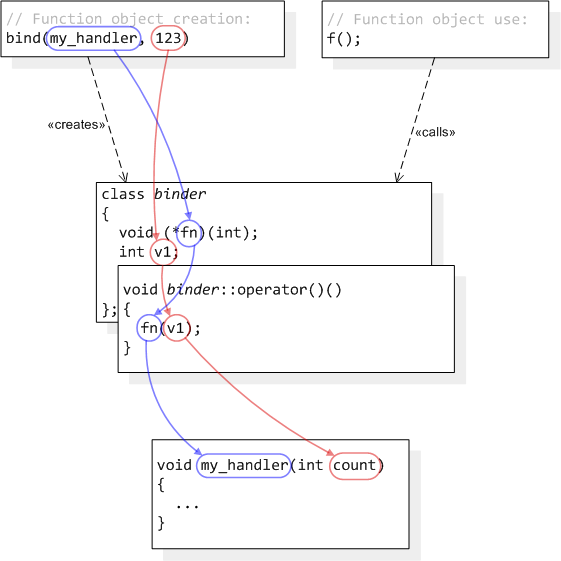
[ click images for full size ]
Binding an argument can be used to turn a class member function into a zero-argument function object. As you know, non-static member functions have an implicit this parameter. This means that an appropriate pointer needs to be bound into the function object:

Alternatively, the implicit this can be made explicit by adapting a member function into a function object taking one argument:

Function objects will often use both bound arguments and arguments supplied at the point of use. This can be done using member functions:
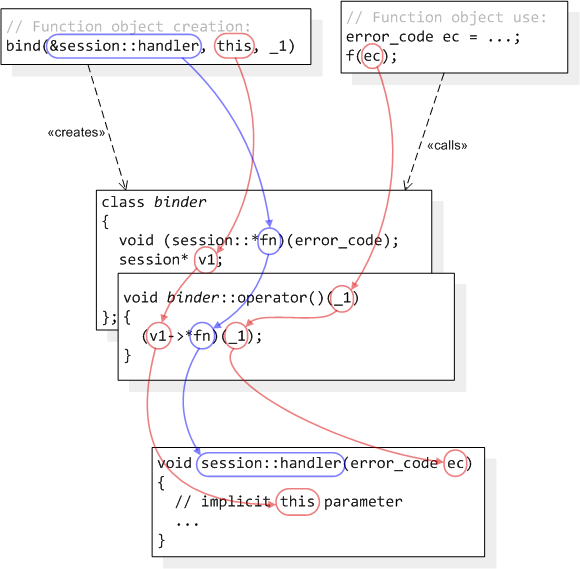
or non-member functions:
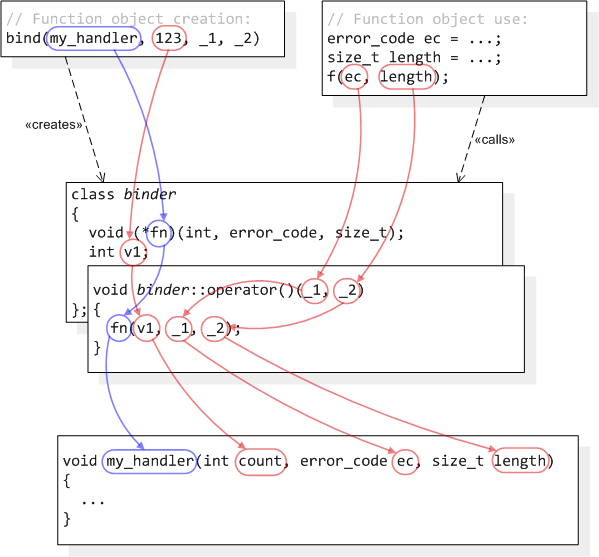
Sometimes the function object's point of use will supply arguments which are not required to call the target function. bind will automatically discard these surplus arguments:
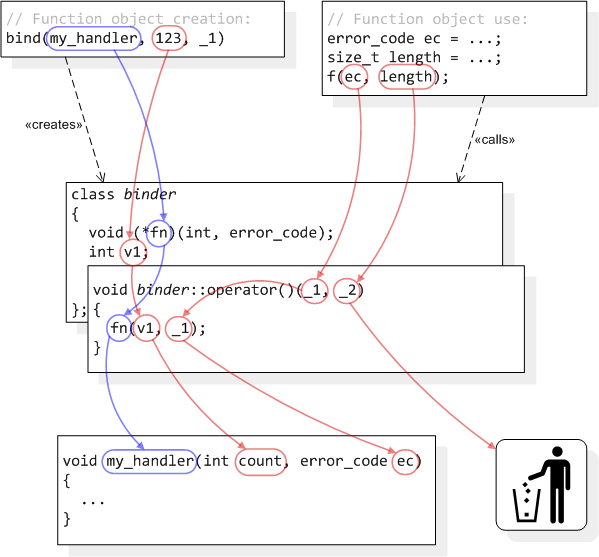
The surplus argument(s) need not be the at the end of the function object signature:
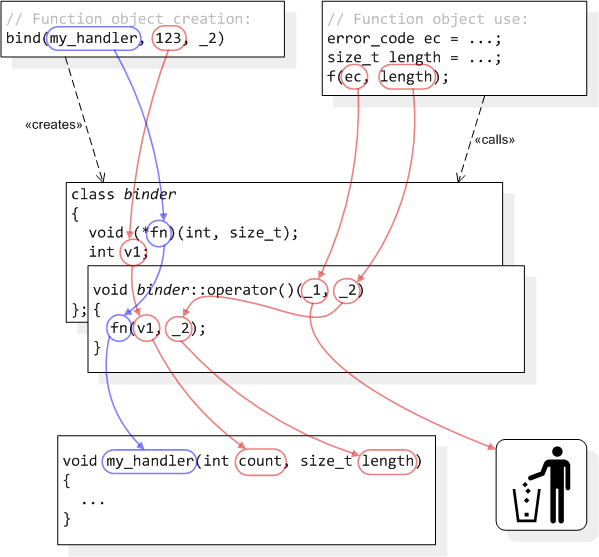
Finally, bind allows you to the reorder arguments to adapt the target function to the necessary function object signature:
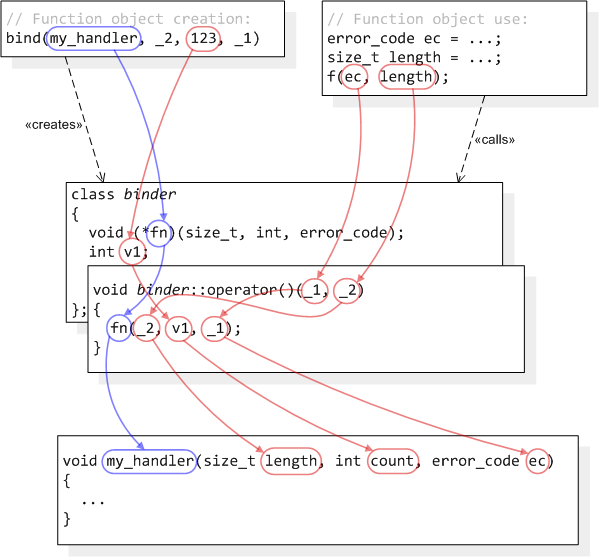
223 comments:
«Oldest ‹Older 201 – 223 of 223Akıllı şehir mobilyaları, akıllı bank akıllı kent mobilyaları için web sitemizi ziyaret edebilirsiniz. Akıllı kent mobilyaları, akıllı bank akıllı şehir mobilyaları için web sitemizi ziyaret edebilirsiniz.
Nice info: https://www.shoviv.com
This is a great explanation of how bind works in the context of asynchronous programming in C++, especially for handling various operation signatures. The examples make it easier to understand how function objects and context can be managed effectively. It reminds me of how in academic work, such as Psychology Assignment Help mastering concepts like function binding and context management can significantly improve the way we approach complex tasks and problem-solving.
Thank you for sharing this informative blog with us. Your blog is very useful for us. If you are a student in Australia and looking for the Best Assignments. Writing compelling introductions and impactful conclusions can be a challenging aspect of academic assignments. The Assignment Help Australia connects students with experienced writers who can craft content that effectively captures the reader’s attention while conveying the intended message clearly. This guidance not only helps in structuring assignments properly but also enhances students’ overall writing skills, making them more confident in their academic work.
I used to think I could wing every marketing case study until I actually read the rubric. Some tasks just need that extra push. So I tried Native Assignment Help Australia and honestly, their Help With Marketing Assignments wasn’t just on time—it was super focused and relevant. Didn’t feel generic at all.
I wasn’t sure about using assignment help services before, but deadlines don’t care about hesitation lol. Native Assignment Help Australia offered such a detailed breakdown of my econ case study that even my tutor noticed the improvement. The team really knows what solid Economics Assignment Assistance looks like, and I appreciate that they didn’t just fluff up the content—they made it better.
This post offers a clear and practical explanation of how `bind` functions in C++ can be used effectively in asynchronous programming, particularly within the context of Asio. One of the key takeaways is how `bind` simplifies passing context, such as member function pointers or additional arguments, into completion handlers. By enabling partial application of function parameters, `bind` bridges the gap between the required function signature and the function's actual interface, making it possible to create flexible and maintainable asynchronous code. Cars for sale in Mombasa Kenya are cheaper at Magari Deals.
The illustrations showing how `bind` handles various scenarios—like discarding surplus arguments, reordering parameters, or binding member functions—are especially helpful. These examples demystify the abstraction that often makes `bind` seem intimidating to many C++ programmers. The post smartly highlights that while compiler errors involving `bind` can be daunting, understanding how it stores and applies arguments makes its use much more intuitive. This is particularly useful when designing handlers that must match specific Asio expectations, such as `handler(error_code ec, size_t length)` for read/write operations.
In modern C++, with the advent of lambdas and `std::function`, some might argue that `bind` is becoming obsolete. However, this post reinforces the idea that `bind` still plays a valuable role, particularly in legacy codebases or when dealing with complex callback structures where lambdas may become verbose. Overall, it's a well-structured guide that helps both novice and experienced developers better understand and apply `bind` in asynchronous C++ programming. Buy Toyota Prado at affordable rate at Magari Deals.
Asynchronous operations in C++ using libraries like Asio often require the use of function objects known as completion handlers. These handlers are triggered when an asynchronous operation completes, with their signatures depending on the operation type. For instance, an `io_service::post()` call needs a handler with no parameters, while asynchronous wait operations expect a handler with an `error_code` parameter. Similarly, asynchronous read/write operations need handlers that accept both an `error_code` and a data length. In complex applications, it is usually necessary to pass context, such as a `this` pointer, to the handler, which is where `boost::bind`, `std::tr1::bind`, or `std::bind` come into play. Buy a car in Kenya from Magari Deals.
The `bind` utility can simplify asynchronous programming by transforming function signatures to match the requirements of handlers. For example, you can bind a specific value to a function expecting one argument, converting it into a zero-argument callable object. This is particularly useful for integrating member functions, which implicitly require a `this` pointer. By binding the instance pointer explicitly, non-static member functions can be adapted to function objects compatible with Asio’s requirements. Moreover, `bind` supports combining bound arguments with runtime-supplied arguments, making it flexible in handling various calling contexts.
An additional feature of `bind` is its ability to ignore unnecessary parameters or reorder them as needed. This allows developers to adapt target functions to the specific function object signatures expected by the asynchronous framework. By leveraging these capabilities, `bind` becomes a powerful tool in simplifying asynchronous function calls in C++, even though it may initially seem complex or "magical" to new users. Toyota land cruiser for sale in Kenya are cheaper at Magari Deals.
After struggling to meet assignment requirements, I turned to Biochemistry Assignment Help For University Students and never looked back. Their team made the hardest topics feel manageable, and my grades improved within weeks. Don’t risk falling behind—connect with the experts now and take control of your academic success!
is heel pain: a sign of cancer? well Heel pain is a common problem worldwide, often caused by conditions like plantar fasciitis, Achilles tendonitis, or minor injuries. Still, many people worry whether heel pain could signal something more serious, such as cancer. While cancer is a rare cause, it’s important to understand when heel pain may need closer attention. This blog explains the common reasons behind heel pain, when it could be a red flag, and how it relates to cancer.
I recently started broadening my horizons in terms of movies and shows, so you can imagine my delight when I found this amazing site! The way fmovies presents their movie reviews is splendid and I appreciate how easy it is to find my next movie. For fans like me, the content is a delight and I was so inspired after reading others’ thoughts to share my experiences. If you enjoy movies or tokusatsu shows, you have to visit fmovies
. The experience is so much fun!
Love watching movies but confused what to pick next? Visit FMovies Review
fmovie
for detailed, spoiler-free reviews of the latest releases. From Hollywood blockbusters to underrated gems, we cover storyline, performances, direction, and audience ratings. Our reviews help you decide whether a movie is worth your time!
Transportation Essay Writing Service is the best writing service for every student. Our writers help students solve educational problems. Our experts provide 24/7 help for students.
Thanks for the article, it is very helpful.⭐️⭐️🌈🌈✨✨
สล็อต
สล็อต เครดิตฟรี
สล็อตออนไลน์
สล็อต 66
สล็อต เว็บตรง
is heel pain: a sign of cancer well Heel pain is a common problem worldwide, often caused by conditions like plantar fasciitis, Achilles tendonitis, or minor injuries. Still, many people worry whether heel pain could signal something more serious, such as cancer. While cancer is a rare cause, it’s important to understand when heel pain may need closer attention. This blog explains the common reasons behind heel pain, when it could be a red flag, and how it relates to cancer.
Join our list of ffree paper shredding events near me 2025 to safely shred confidential papers and unwanted documents. Find upcoming community shredding days, secure your identity, and support local green recycling efforts.
5 Minute Morning Meditation
The best and most direct method for image extraction is usually converting to EML or MSG and accessing the attachments directly from the output files. mbox to pst
Progress under Next Yojana could boost female entrepreneurship, business grants, digital literacy, and interest-free loans for underprivileged women, building self-reliance and long-term empowerment opportunities.
Local families seeking privacy protection are encouraged to participate in community-driven recycling programs where important documents are destroyed securely, and many upcoming initiatives include well-organized free paper shredding events near me 2025 designed to promote safety, awareness, convenience, environmental responsibility, and secure paper handling practices throughout the year.
Posts exploring CSL Plasma $700 Coupon 2025 often examine past earning cycles, donor feedback, and predicted variations in bonus periods, supporting a clearer understanding of how plasma center incentives change over time.
Great breakdown of how bind works your diagrams make a tricky concept much easier to grasp. This kind of clear explanation is as refreshing as the clean, structured workflow I get from working with Vista Pools LLC on my projects.
Post a Comment